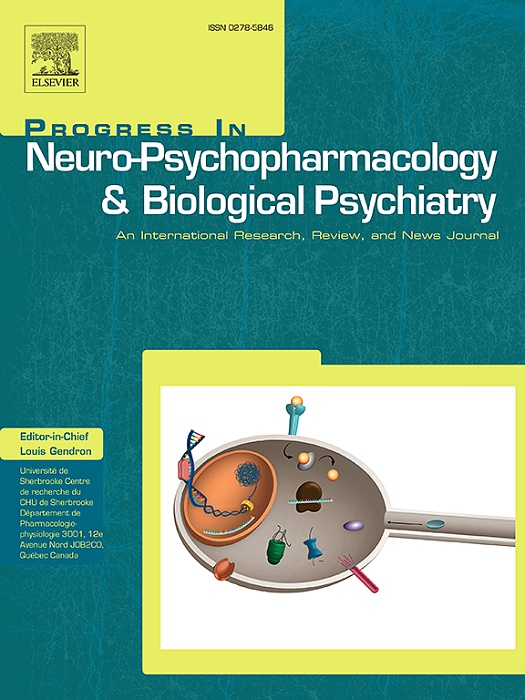Abnormal intrinsic brain functional network dynamics in stroke and correlation with neuropsychiatric symptoms revealed based on lesion and cerebral blood flow
IF 5.3
2区 医学
Q1 CLINICAL NEUROLOGY
Progress in Neuro-Psychopharmacology & Biological Psychiatry
Pub Date : 2024-10-28
DOI:10.1016/j.pnpbp.2024.111181
引用次数: 0
Abstract
There has been a lack of clarity about the mechanisms of widespread network dysfunctions after stroke. This study aimed to reveal dynamic functional network alternations following stroke based on lesion and brain perfusion. We prospectively enrolled 125 acute ischaemic stroke patients (25 were transient ischemic attack (TIA) patients) and 49 healthy controls with assessed the severity of their depression, anxiety, fatigue, and apathy. We performed dynamic functional network connectivity (DFNC) analysis using the sliding window method. The common static FC biomarkers of stroke were used to define functional states and calculated stroke-specific changes in dynamic indicators. Next, ridge regression (RR) analyses were performed on the dynamic indicators using voxel-wise lesion maps, cerebral blood flow (CBF) difference maps (removal of voxels overlapping lesions) and a combination of both. Mediation analyses were used to characterize the effect of dynamic networks changes on the relationship between lesion, CBF, and neuropsychological scores. Our results showed that DFNC identified three functional states with three dynamic metrics extracted for subsequent analyses. RR analyses show that both CBF and lesions partially explain post-stroke dysfunction (CBF: dynamic indicator1: R2 = 0.110, p = 0.163; dynamic indicator2: R2 = 0.277, p = 0.006; dynamic indicator3: R2 = 0.125, p = 0.121; lesion: dynamic indicator1: R2 = 0.132, p = 0.109; dynamic indicator2: R2 = 0.238, p = 0.015; dynamic indicator3: R2 = 0.131, p = 0.110). In addition, combining the two can improve the efficacy of explanations. Finally, exploratory mediation analyses identified that dynamic functional network changes can mediate between CBF, lesion and neuropsychiatric disorders. Our results suggest that CBF and lesion can be combined to improve the interpretation of dynamic network dysfunction after stroke.
基于病变和脑血流揭示脑卒中固有脑功能网络动态异常及与神经精神症状的相关性
脑卒中后广泛的网络功能障碍的机制尚不清楚。本研究旨在揭示中风后基于病变和脑灌注的动态功能网络交替。我们前瞻性地招募了 125 名急性缺血性脑卒中患者(其中 25 人为短暂性脑缺血发作(TIA)患者)和 49 名健康对照者,并评估了他们抑郁、焦虑、疲劳和冷漠的严重程度。我们采用滑动窗口法进行了动态功能网络连通性(DFNC)分析。我们使用中风常见的静态 FC 生物标记物来定义功能状态,并计算中风特异性动态指标的变化。接着,我们使用体素病灶图、脑血流(CBF)差图(去除重叠病灶的体素)以及两者的组合对动态指标进行了脊回归(RR)分析。我们使用中介分析来描述动态网络变化对病变、CBF 和神经心理评分之间关系的影响。我们的结果表明,DFNC 确定了三种功能状态,并提取了三种动态指标用于后续分析。RR分析表明,CBF和病变都能部分解释卒中后的功能障碍(CBF:动态指标1:R2=0.110,p=0.163;动态指标2:R2=0.277,p=0.006;动态指标3:R2=0.125,p=0.121;病变:动态指标1:R2=0.132,p=0.109;动态指标2:R2=0.238,p=0.015;动态指标3:R2=0.131,p=0.110)。此外,将两者结合起来可以提高解释的有效性。最后,探索性中介分析发现,动态功能网络变化可以在 CBF、病变和神经精神障碍之间起到中介作用。我们的研究结果表明,将 CBF 和病变结合起来可以改善对卒中后动态网络功能障碍的解释。
本文章由计算机程序翻译,如有差异,请以英文原文为准。
求助全文
约1分钟内获得全文
求助全文
来源期刊
CiteScore
12.00
自引率
1.80%
发文量
153
审稿时长
56 days
期刊介绍:
Progress in Neuro-Psychopharmacology & Biological Psychiatry is an international and multidisciplinary journal which aims to ensure the rapid publication of authoritative reviews and research papers dealing with experimental and clinical aspects of neuro-psychopharmacology and biological psychiatry. Issues of the journal are regularly devoted wholly in or in part to a topical subject.
Progress in Neuro-Psychopharmacology & Biological Psychiatry does not publish work on the actions of biological extracts unless the pharmacological active molecular substrate and/or specific receptor binding properties of the extract compounds are elucidated.

 求助内容:
求助内容: 应助结果提醒方式:
应助结果提醒方式:


